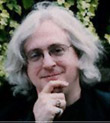|
|
|||||
|
|
|||||
 Larry Yaeger is a Distinguished Scientist and programmer who has made leading technical contributions in a variety of fields. He was educated in Aerospace Engineering at Purdue University (B.S.) and Polytechnic Institute of New York (M.S.). He currently telecommutes full time from scenic Beanblossom, Indiana for Apple Computer's Macintosh System Software division, working on pen, ink, and handwriting recognition issues. Larry Yaeger is a Distinguished Scientist and programmer who has made leading technical contributions in a variety of fields. He was educated in Aerospace Engineering at Purdue University (B.S.) and Polytechnic Institute of New York (M.S.). He currently telecommutes full time from scenic Beanblossom, Indiana for Apple Computer's Macintosh System Software division, working on pen, ink, and handwriting recognition issues.
Mr. Yaeger's original work in computational fluid dynamics produced what were probably the first fully three-dimensional hypersonic flow field studies over the space shuttle, for Grumman Aerospace. As part of this work he co-developed a novel three-dimensional geometry modeling system ("Quick") in 1972 that is still in use today. He also carried out pioneering fluid dynamics studies for aircraft engines, laser cavities, rocket engines, and other systems, including the world's first whole-body computational solution for flow over a submarine (incorporating hull effects, lifting surface flows, and turbulent wake effects). Turning to computer graphics, Mr. Yaeger served as Director of Software Development for essentially the full life of the pioneering computer special effects house, Digital Productions, from 1982 to 1987. He also Joining Alan Kay's Vivarium Program at Apple Computer in 1987, Mr. Yaeger extended Terry Sejnowski's famous NETtalk neural network speech synthesizer work to include phonemic stress prediction; designed and programmed a computer "voice" for Koko the gorilla; helped introduce Macintoshes into routine production on Star Trek: The Next Generation; and created a widely respected Artificial Life computational ecology ("PolyWorld") that evolves neural architectures resulting from the mutation and recombination of genetic codes, via behavior-based, sexual reproduction of artificial organisms. Originally presented at the Artificial Life III conference in Santa Fe in 1992, PolyWorld and Mr. Yaeger's seminal publication on this subject continue to inspire interest and research in the field, including through use as teaching materials at universities worldwide. As part of Apple's Advanced Technology Group, Mr. Yaeger was principal author and Technical Lead in the development of a neural network-based handwriting recognition technology that many have deemed the "first usable" such technology in the world. This technology shipped as the "Print Recognizer" in second and subsequent generation Newton PDAs. It was hailed for "saving" the Newton at the time, though other issues led to the platform's ultimate demise. Mr. Yaeger is currently investigating the graceful transition of this technology into the Macintosh OS. Mr. Yaeger holds various patents issued and pending in the areas of collision detection and handwriting recognition. He has published key papers in each of the areas in which he has worked, and has spoken widely on the subjects of computer graphics, artificial life, and handwriting recognition. He has received a variety of awards for his pioneering efforts, including the Grumman Project Sterling Award for New Technology, the NASA New Technology Award, the Rocketdyne President's Achievement Award, and the "Best Digital World" award at the Artificial Life III conference. His interest in artificial life remains wholly unabated, despite being forced to focus on more immediately deployable technologies for the past few years. Abstract of discussion: Evolution is a tautology. Three, actually: "That which survives persists." "That which reproduces increases its numbers." And, "Things change." (Okay, two tautologies and a truism.) By looking around us we can see that "life" seems to be a natural outcome of this tautology. "Life" happens to be the word we English-speakers apply to things that are sufficiently complex and exhibit certain self-sustaining and self-propagating behaviors. In nature, life exists in a spectrum of complexity from the simplest reproducing molecular chains all the way up to ALife researchers. If we pay attention to such things, "intelligence" seems to be another natural outcome of this tautology, evolution. "Intelligence" is the word we use to describe complex adaptive behavior. Too often we limit the application of the word "intelligence" to humans, when any first hand experience with a wide variety of members of the animal kingdom will demonstrate quite clearly that they too learn and adapt continuously, in quite complex ways. Indeed, in nature, intelligence exists in a spectrum of complexity from the simplest chemical gradient-climbing micro-organisms (at least) all the way up to, well, ALife researchers. Given that life and intelligence seem to be natural, emergent properties of the processes of evolution and natural selection, it hardly seems fair to label as "artificial" the attempts by various researchers to evoke life Well lucky us. As humans have matured as a race, we've developed a clear enough understanding of the fundamental principles at work in our universe to bend matter and energy to our wills in a great variety of ways. Now, at long last, we've hit upon the simple expedient of bending the evolutionary tautology to our will, in our pursuit of the understanding and the creation of life and intelligence. And we will succeed. What I think we'll find and understand as we pursue these goals, is that life and intelligence are only subtly different characteristics of the products of evolution. Things that survive, reproduce, and adapt must be called alive, and must be called intelligent, only to varying degrees. No imponderable mystery, no unscientific magic, but great beauty and the capacity to wonder at that beauty are our natural legacy, and that of our "artificial" offspring to come.
|
|||||
 |
 |
 |
 |
|
 |
Digital Biota 2 is sponsored by
